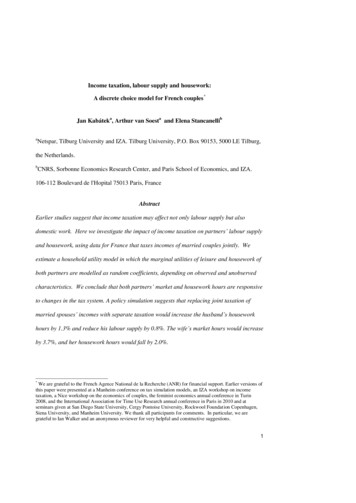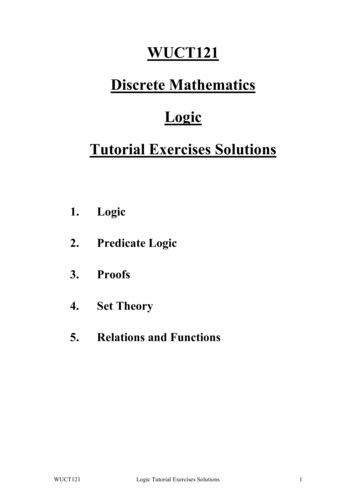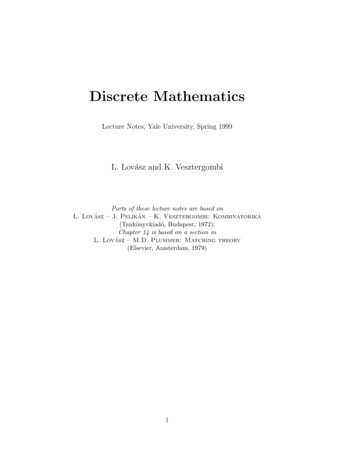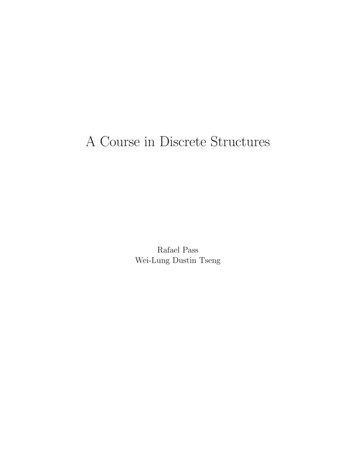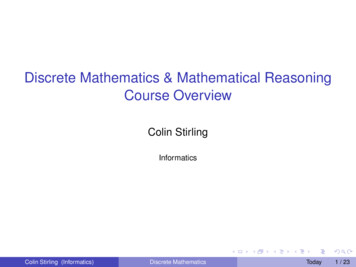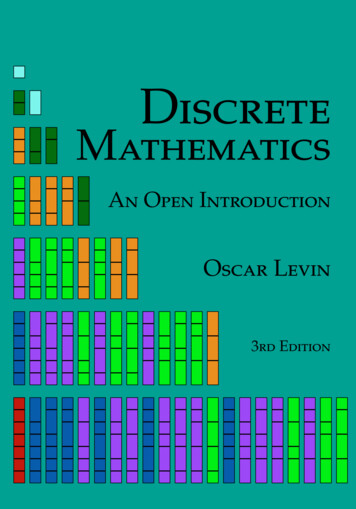
Transcription
DiscreteMathematicsAn Open IntroductionOscar Levin3rd Edition
DiscreteMathematicsAn Open IntroductionOscar Levin3rd Edition
Oscar LevinSchool of Mathematical ScienceUniversity of Northern ColoradoGreeley, Co m/ 2013-2021 by Oscar LevinThis work is licensed under the Creative Commons Attribution-ShareAlike4.0 International License. To view a copy of this license, /.3rd Edition5th Printing: 1/7/2021ISBN: 978-1792901690A current version can always be found for free athttp://discrete.openmathbooks.org/Cover image: Tiling with Fibonacci and Pascal.
For Madeline and Teagan
AcknowledgementsThis book would not exist if not for “Discrete and Combinatorial Mathematics” by Richard Grassl and Tabitha Mingus. It is the book I learneddiscrete math out of, and taught out of the semester before I began writingthis text. I wanted to maintain the inquiry based feel of their book butupdate, expand and rearrange some of the material. Some of the bestexposition and exercises here were graciously donated from this source.Thanks to Alees Seehausen who co-taught the Discrete Mathematicscourse with me in 2015 and helped develop many of the Investigate!activities and other problems currently used in the text. She also offeredmany suggestions for improvement of the expository text, for which I amquite grateful. Thanks also to Katie Morrison, Nate Eldredge and RichardGrassl (again) for their suggestions after using parts of this text in theirclasses.While odds are that there are still errors and typos in the current book,there are many fewer thanks to the work of Michelle Morgan over thesummer of 2016.The book is now available in an interactive online format, and this isentirely thanks to the work of Rob Beezer, David Farmer, and Alex Jordanalong with the rest of the participants of the pretext-support group.Finally, a thank you to the numerous students who have pointed outtypos and made suggestions over the years and a thanks in advance tothose who will do so in the future.v
vi
PrefaceThis text aims to give an introduction to select topics in discrete mathematics at a level appropriate for first or second year undergraduate mathmajors, especially those who intend to teach middle and high school mathematics. The book began as a set of notes for the Discrete Mathematicscourse at the University of Northern Colorado. This course serves both asa survey of the topics in discrete math and as the “bridge” course for mathmajors, as UNC does not offer a separate “introduction to proofs” course.Most students who take the course plan to teach, although there are ahandful of students who will go on to graduate school or study appliedmath or computer science. For these students the current text hopefullyis still of interest, but the intent is not to provide a solid mathematicalfoundation for computer science, unlike the majority of textbooks on thesubject.Another difference between this text and most other discrete mathbooks is that this book is intended to be used in a class taught usingproblem oriented or inquiry based methods. When I teach the class, I willassign sections for reading after first introducing them in class by usinga mix of group work and class discussion on a few interesting problems.The text is meant to consolidate what we discover in class and serve as areference for students as they master the concepts and techniques coveredin the unit. None-the-less, every attempt has been made to make the textsufficient for self study as well, in a way that hopefully mimics an inquirybased classroom.The topics covered in this text were chosen to match the needs ofthe students I teach at UNC. The main areas of study are combinatorics,sequences, logic and proofs, and graph theory, in that order. Induction iscovered at the end of the chapter on sequences. Most discrete books putlogic first as a preliminary, which certainly has its advantages. However, Iwanted to discuss logic and proofs together, and found that doing bothof these before anything else was overwhelming for my students giventhat they didn’t yet have context of other problems in the subject. Also,after spending a couple weeks on proofs, we would hardly use that atall when covering combinatorics, so much of the progress we made wasquickly lost. Instead, there is a short introduction section on mathematicalstatements, which should provide enough common language to discussthe logical content of combinatorics and sequences.Depending on the speed of the class, it might be possible to includeadditional material. In past semesters I have included generating functions(after sequences) and some basic number theory (either after the logic andvii
viiiproofs chapter or at the very end of the course). These additional topicsare covered in the last chapter.While I (currently) believe this selection and order of topics is optimal,you should feel free to skip around to what interests you. There areoccasionally examples and exercises that rely on earlier material, but Ihave tried to keep these to a minimum and usually can either be skippedor understood without too much additional study. If you are an instructor,feel free to edit the LATEX or PreTeXt source to fit your needs.Improvements to the 3rd Edition.In addition to lots of minor corrections, both to typographical and mathematical errors, this third edition includes a few major improvements,including: More than 100 new exercises, bringing the total to 473. The selectionof which exercises have solutions has also been improved, whichshould make the text more useful for instructors who want to assignhomework from the book. A new section in on trees in the graph theory chapter. Substantial improvement to the exposition in chapter 0, especiallythe section on functions. The interactive online version of the book has added interactivity.Currently, many of the exercises are displayed as WeBWorK problems,allowing readers to enter answers to verify they are correct.The previous editions (2nd edition, released in August 2016, and theFall 2015 edition) will still be available for instructors who wish to usethose versions due to familiarity.My hope is to continue improving the book, releasing a new editioneach spring in time for fall adoptions. These new editions will incorporateadditions and corrections suggested by instructors and students who usethe text the previous semesters. Thus I encourage you to send along anysuggestions and comments as you have them.Oscar Levin, Ph.D.University of Northern Colorado, 2019
How to use this bookIn addition to expository text, this book has a few features designed toencourage you to interact with the mathematics.Investigate! activities.Sprinkled throughout the sections (usually at the very beginning of a topic)you will find activities designed to get you acquainted with the topic soonto be discussed. These are similar (sometimes identical) to group activitiesI give students to introduce material. You really should spend some timethinking about, or even working through, these problems before readingthe section. By priming yourself to the types of issues involved in thematerial you are about to read, you will better understand what is to come.There are no solutions provided for these problems, but don’t worry if youcan’t solve them or are not confident in your answers. My hope is that youwill take this frustration with you while you read the proceeding section.By the time you are done with the section, things should be much clearer.Examples.I have tried to include the “correct” number of examples. For thoseexamples which include problems, full solutions are included. Beforereading the solution, try to at least have an understanding of what theproblem is asking. Unlike some textbooks, the examples are not meant tobe all inclusive for problems you will see in the exercises. They shouldnot be used as a blueprint for solving other problems. Instead, use theexamples to deepen our understanding of the concepts and techniquesdiscussed in each section. Then use this understanding to solve theexercises at the end of each section.Exercises.You get good at math through practice. Each section concludes witha small number of exercises meant to solidify concepts and basic skillspresented in that section. At the end of each chapter, a larger collection ofsimilar exercises is included (as a sort of “chapter review”) which mightbridge material of different sections in that chapter. Many exercise havea hint or solution (which in the PDF version of the text can be found byclicking on the exercise number—clicking on the solution number willbring you back to the exercise). Readers are encouraged to try theseexercises before looking at the help.ix
xBoth hints and solutions are intended as a way to check your work,but often what would “count” as a correct solution in a math class wouldbe quite a bit more. When I teach with this book, I assign exercises thathave solutions as practice and then use them, or similar problems, onquizzes and exams. There are also problems without solutions to challengeyourself (or to be assigned as homework).Interactive Online Version.For those of you reading this in a PDF or in print, I encourage you toalso check out the interactive online version, which makes navigating thebook a little easier. Additionally, some of the exercises are implementedas WeBWorK problems, which allow you to check your work withoutseeing the correct answer immediately. Additional interactivity is planned,including instructional videos for examples and additional exercises at theend of sections. These “bonus” features will be added on a rolling basis,so keep an eye out!You can view the interactive version for free at http://discrete.openmathbooks.org/ or by scanning the QR code below with your smartphone.
ContentsAcknowledgementsvPrefaceviiHow to use this bookix0Introduction and Preliminaries0.1 What is Discrete Mathematics? . . .0.2 Mathematical Statements . . . . . . .Atomic and Molecular Statements .Implications . . . . . . . . . . . . . .Predicates and Quantifiers . . . . . .Exercises . . . . . . . . . . . . . . . .0.3 Sets . . . . . . . . . . . . . . . . . . .Notation . . . . . . . . . . . . . . . .Relationships Between Sets . . . . .Operations On Sets . . . . . . . . . .Venn Diagrams . . . . . . . . . . . .Exercises . . . . . . . . . . . . . . . .0.4 Functions . . . . . . . . . . . . . . . .Describing Functions . . . . . . . . .Surjections, Injections, and BijectionsImage and Inverse Image . . . . . . .Exercises . . . . . . . . . . . . . . . .11447151724242831333539404548511Counting1.1 Additive and Multiplicative PrinciplesCounting With Sets . . . . . . . . . . .Principle of Inclusion/Exclusion . . .Exercises . . . . . . . . . . . . . . . . .1.2 Binomial Coefficients . . . . . . . . . .Subsets . . . . . . . . . . . . . . . . . .Bit Strings . . . . . . . . . . . . . . . .Lattice Paths . . . . . . . . . . . . . . .Binomial Coefficients . . . . . . . . . .Pascal’s Triangle . . . . . . . . . . . . .Exercises . . . . . . . . . . . . . . . . .1.3 Combinations and Permutations . . .Exercises . . . . . . . . . . . . . . . . .1.4 Combinatorial Proofs . . . . . . . . . .575761646770707273747778818689xi.
xiiContents1.51.61.7Patterns in Pascal’s Triangle . .More Proofs . . . . . . . . . . .Exercises . . . . . . . . . . . . .Stars and Bars . . . . . . . . . .Exercises . . . . . . . . . . . . .Advanced Counting Using PIECounting Derangements . . . .Counting Functions . . . . . . .Exercises . . . . . . . . . . . . .Chapter Summary . . . . . . . .Chapter Review . . . . . . . . .8995991031081111151171241271282Sequences2.1 Describing Sequences . . . . . . . . . . . . . . .Exercises . . . . . . . . . . . . . . . . . . . . . .2.2 Arithmetic and Geometric Sequences . . . . . .Sums of Arithmetic and Geometric SequencesExercises . . . . . . . . . . . . . . . . . . . . . .2.3 Polynomial Fitting . . . . . . . . . . . . . . . . .Exercises . . . . . . . . . . . . . . . . . . . . . .2.4 Solving Recurrence Relations . . . . . . . . . .The Characteristic Root Technique . . . . . . .Exercises . . . . . . . . . . . . . . . . . . . . . .2.5 Induction . . . . . . . . . . . . . . . . . . . . . .Stamps . . . . . . . . . . . . . . . . . . . . . . .Formalizing Proofs . . . . . . . . . . . . . . . .Examples . . . . . . . . . . . . . . . . . . . . . .Strong Induction . . . . . . . . . . . . . . . . .Exercises . . . . . . . . . . . . . . . . . . . . . .2.6 Chapter Summary . . . . . . . . . . . . . . . . .Chapter Review . . . . . . . . . . . . . . . . . 881931943Symbolic Logic and Proofs3.1 Propositional Logic . . . . .Truth Tables . . . . . . . . .Logical Equivalence . . . . .Deductions . . . . . . . . . .Beyond Propositions . . . .Exercises . . . . . . . . . . .3.2 Proofs . . . . . . . . . . . . .Direct Proof . . . . . . . . .Proof by Contrapositive . .Proof by Contradiction . . .Proof by (counter) Example.197198199201204207209213215216218220.
What is Discrete Mathematics? 3 wewillstudyfourmaintopics: combinatorics (thetheoryofwaysthings combine ;inparticular,howtocounttheseways), sequences , symbolic


